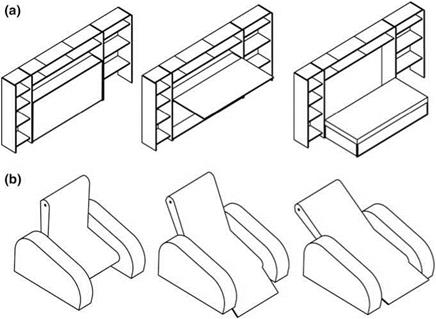The expected function of a product has an essential influence on its form and constructional solutions. Every piece of furniture should meet a specific function, strictly connecting with the method, character and place of its use. In many cases, the function of a product is the factor which is the most inspiring to seek new shapes and artistic expression. For millennia, the human being has been refining the functionality of furniture, thus affecting its structural form and technology of production. By derogating from formerly existing conventions, we now sit on a chair with relaxed muscles, which is why the form of its seat is different. The distance of the seat from the base (floor), as well as the angle of this seat and backrest, has also changed. In this way, dimensional proportions changed, as did the distribution of fixed and moving parts of a furniture piece and the place of its use. Mostly, furniture with one well designed and technically solved function was thought of. Multifunctional furniture appeared along with the deterioration of living conditions and the necessity to maximise the use of housing space. These were products,
|
Fig. 3.5 Multifunctional furniture: a negative interaction between functions, b creative overlapping of functions |
which after transformation of certain elements enabled the following: work, dining, storage, sleep and rest. As a rule, they were distinguished by simple form and unsophisticated style, heavily dominated by technology ensuring the fulfilment of a number of user requirements at the same time. However, it should be pointed out that providing comfort for the user through comprehensively fulfilling many very different functions in one furniture piece is not possible, as these functions will mutually limit themselves greatly. In a classic shelf-couch, none of the functions of the furniture piece are adequately ensured (Fig. 3.5a). The number of compartments for storage is limited by the dimensions and location of the mattress, which is folded vertically. The construction of the mattress depends on the depth of the shelf, which limits the number of elastic layers affecting comfort of sleep and rest. The surface of worktops, which are usually lifted boards of the bottom of the couch’s container, depends on the dimensions of the mattress. Therefore, the user of a hybrid furniture piece (multifunctional) cannot count on comfortable rest, pleasant work at a table and free access to many of the stored items. In furniture of this type, however, the constructional and technological solutions which ensure the synthesis of many different functions and closing them in one compact block of a furniture piece are inspiring.
Modern multifunctionality of furniture, however, has a second, more beneficial side. Designers and constructors work on the forms of furniture that stand out with many highly integrated and mutually dependent functions. This group can include kitchen furniture with functions of storage, supporting silent opening and closing, lighting and memorising the number and type of stored products. Another example can be upholstered furniture designed for sitting and leisure with the function of unfolding the seat, footrest extension, massage, heating, assisting sitting down and standing up. As it is demonstrated, none of these functions limit others and itself (Fig. 3.5b). Harmonious cooperation between the form and functions of a furniture piece, as well as innovative design solutions, modern technology and original ecological materials, ensures that a product designed in such a way will be considered a high-end product of excellent quality. In this sense, the multifunctionality of furniture, and so the ability to adapt it to the growing needs of customers, is a huge advantage, which builds a strong brand of the product and distance products that are less developed.
Therefore, the modern concept of the function of a furniture piece has acquired a new meaning and a new quality. A piece of furniture with a function is mostly a product imbued with electronics and automation, improving the quality, comfort and safety of use, presented in modern proportions and design lines. Therefore, it is also worth noting that multifunctionality, in contrast to previous periods, is increasingly accompanying luxurious furniture of high quality. Therefore, the innovative constructional solutions introduced must work efficiently, reliably and safely.
In addition to the importance of the functions of a product, in industrial design, its functionality also plays a key role, i. e. adjusting the functions of a furniture piece to both physical and psychological requirements of the user (Dzi^gielewski and Smardzewski 1995). The functionality of a furniture piece is primarily determined by the direct contact of the object or its part with the body of the user. The actual expression of this functionality is the dimensions, shape and quality of realisation, as well as in some cases, the type of material used.




